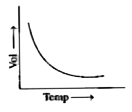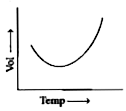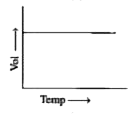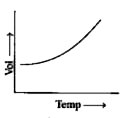The melting point of naphthalene is 80∘C and the room temperature is 30∘C. A sample of liquid naphthalene at 100∘C is cooled down to the room temperature. Draw a temperature time graph to represent this cooling. In the graph, mark the region which corresponds to the freezing process.
To solve the problem, we need to create a temperature-time graph for the cooling of naphthalene from 100°C to room temperature (30°C). The melting point of naphthalene is 80°C, which is crucial for marking the freezing process on the graph.
1. Identify Initial and Final Temperatures:
- Initial Temperature (T_initial) = 100°C (the temperature of the liquid naphthalene).
- Final Temperature (T_final) = 30°C (room temperature).
2. Identify the Melting Point:
- The melting point of naphthalene is 80°C. This is the temperature at which naphthalene transitions from liquid to solid.
3. Cooling Process:
- As the naphthalene cools from 100°C to 80°C, it remains in the liquid state.
- When the temperature reaches 80°C, the naphthalene begins to freeze, transitioning from liquid to solid.
4. Mark the Freezing Process:
- The freezing process occurs at 80°C and continues until the temperature drops to the solid state.
5. Cooling Below Freezing Point:
- After the freezing process at 80°C, the temperature continues to drop until it reaches room temperature at 30°C.
6. Draw the Graph:
- On the x-axis, represent time, and on the y-axis, represent temperature (°C).
- Start at 100°C and draw a straight line down to 80°C (liquid state).
- At 80°C, draw a horizontal line indicating the freezing process (liquid to solid).
- Continue drawing a line down from 80°C to 30°C (solid state).
Graph Summary:
- Liquid State: From 100°C to 80°C (decreasing slope).
- Freezing Process: From 80°C (horizontal line).
- Solid State: From 80°C to 30°C (decreasing slope).
- Initial Temperature (T_initial) = 100°C (the temperature of the liquid naphthalene).
- Final Temperature (T_final) = 30°C (room temperature).
- The melting point of naphthalene is 80°C. This is the temperature at which naphthalene transitions from liquid to solid.
- As the naphthalene cools from 100°C to 80°C, it remains in the liquid state.
- When the temperature reaches 80°C, the naphthalene begins to freeze, transitioning from liquid to solid.
- The freezing process occurs at 80°C and continues until the temperature drops to the solid state.
- After the freezing process at 80°C, the temperature continues to drop until it reaches room temperature at 30°C.
- On the x-axis, represent time, and on the y-axis, represent temperature (°C).
- Start at 100°C and draw a straight line down to 80°C (liquid state).
- At 80°C, draw a horizontal line indicating the freezing process (liquid to solid).
- Continue drawing a line down from 80°C to 30°C (solid state).
- Liquid State: From 100°C to 80°C (decreasing slope).
- Freezing Process: From 80°C (horizontal line).
- Solid State: From 80°C to 30°C (decreasing slope).
Topper's Solved these Questions
Similar Questions
Knowledge Check
The relation between volume and temperature of a sample of water in the range 0∘C to 100∘C is best represented by
A B
B C
C D
D
A certain freezing process requires that room temperature be lowered from 40∘C at a rate of 5∘C at every hour. Find the room temperature 10 hours after the freezing process begins.
A−12∘CB−10∘CC10∘CD9∘C
A certain mass of ice at 0∘C is converted to steam at 100∘C by constant heating, Draw temperature-time graph showing the change in phases.
View SolutionA certain mass of ice at 0∘C is converted to steam at 100∘C by constant heating, Draw temperature-time graph showing the change in phases.
View Solution1 kg of ice at 0∘C is heated at a constant rate and its temperature is recorded after every 30 s till steam is formed at 100∘C. Draw a temperature-time graph to represent the change of phases.
View SolutionA calorimeter of heat capacity 100J/K is at room temperature of 30∘C. 100g of water at 40∘C of specific heat 4200J/kg−K is poured into the calorimeter. What is the temperature of water is calorimeter?
View SolutionThe temperature and the dew point in an open room are 20∘Cand10∘C.if the room temperature drops to 15∘C,what will be the new dew point?
View SolutionA metallic sphere cools from 50∘C to 40∘C in 300 seconds. If the room temperature is 20∘C then its temperature in next 5 minutes will be -
View Solution
